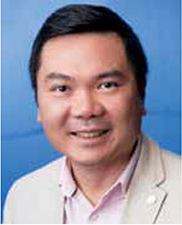Cheerleader-in-chief
 |
| Dr Matthew Chow |
A colleague recently asked if I have ever been a pastor or a motivational speaker; it’s probably one of the nicest compliments I’ve ever received. Since stepping into my presidency, I’ve heard a lot about all that is unfair, unjust, and just plain wrong. Some of you have been hurting badly, even long before the pandemic struck, and our profession and our society face serious challenges ahead. As president, I feel a relentless optimism and urge to cheer the profession onward—as a cheerleader-in-chief if you will.
Driving my optimism is learning that, in spite of these uncertain times, people want very similar things in life. It doesn’t matter if you ask a physician, a ministry official, or even someone you run into on the street. Most will describe the same thing—they want respect, meaningful relationships, satisfying work, financial security, and the opportunity to fully realize their potential. The person who has different political, social, or cultural beliefs from you, the one who is currently in conflict with you, the friend who sits across the table from you, they all share 99.9% of your genes. We are more similar than we are different. And chances are that if you experienced similar childhoods, share similar family histories, faced the same challenges, or have the same responsibilities, then you might find yourselves thinking and behaving in a similar way.
I’ve come across a lot of different people in my life. Young people. Older people. Disadvantaged people. Privileged people. Community activists. Military veterans. City folk. Rural dwellers. Left leaning. Right leaning. But dig deep enough and they all seem to want the same basic things. And doctors are no different. Doctors are people, after all.
Perhaps this is why I feel so optimistic about the future. No matter what our differences may be, no matter where our approach to life takes us, we all seem to have a common thread that connects us. We have seen this throughout the pandemic—our profession, our society, has come together to overcome this formidable challenge. There have been incredible feats of courage and sacrifice to save lives. A global effort yielded multiple vaccines that have brought us ever closer to our previous freedoms. The medical profession has fought this pandemic with all the skills, experience, and compassion available to us, from the Office of the Provincial Health Officer, to the BC Centre for Disease Control, to laboratories and testing sites across the province, to surgical suites and community offices, to individual relationships with patients and families. We fought this pandemic as one.
As a medical leader, my skills and abilities pale in comparison to those of all the doctors around me who are brimming with talent; doctors who will shape the future of medicine and our society. Some are young up-and-comers. Some are folks who have worked in this system for many years. Some are in underrepresented groups. Some are seemingly well represented but their ideas may not be. Unfortunately, these colleagues face some common challenges: they feel unheard and disrespected. They face systemic barriers to meaningfully participate. They lack mentorship. They are subject to assumptions because of the demographic they belong to. If you look around with open eyes and an open mind, you will find these people—people who need barriers removed, confidence boosted, sponsorship into leadership positions, and sometimes for us to get out of their way so that they can shine.
An important part of my role as president is to be a cheerleader for the profession, especially for individuals who face challenges. That’s what I mean about being a cheerleader-in-chief. My role is to motivate, enable, facilitate, sponsor, and mentor 14 000 of my colleagues, especially those who are smarter, kinder, more skilled, and more compassionate than I am. And there are a lot of you. It makes for a busy job, but I wouldn’t have it any other way. I truly am optimistic about the future, and I will continue to cheer you all on, long after my term is over.
I wish you, your families, and everyone you hold dear a glorious summer. I hope you take time to relax and recharge. Better days are upon us with many more still to come.
—Matthew C. Chow, MD
Doctors of BC President
hidden
The online version of this President's Comment was updated on 14 July.


Just a simple thanks for the work you do and the way you do it, Matthew. We are lucky to have you at the helm at this time! I really appreciated your cheerleader-in-chief article and the perspective you bring to the work you do in representing us all and striving to improve our achievement of common goals.